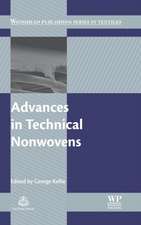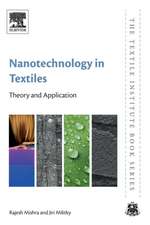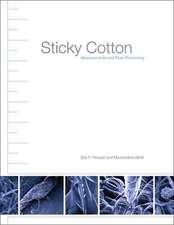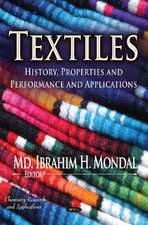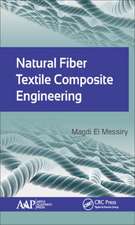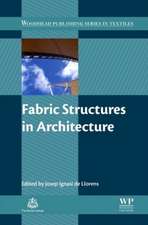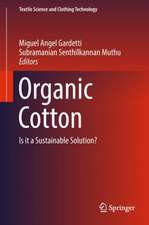Textile Technology and Design: From Interior Space to Outer Space
Editat de Deborah Schneiderman, Alexa Griffith Wintonen Limba Engleză Paperback – 27 ian 2016
| Toate formatele și edițiile | Preț | Express |
|---|---|---|
| Paperback (1) | 175.39 lei 6-8 săpt. | |
| Bloomsbury Publishing – 27 ian 2016 | 175.39 lei 6-8 săpt. | |
| Hardback (1) | 716.39 lei 6-8 săpt. | |
| Bloomsbury Publishing – 27 ian 2016 | 716.39 lei 6-8 săpt. |
Preț: 175.39 lei
Preț vechi: 201.90 lei
-13% Nou
Puncte Express: 263
Preț estimativ în valută:
33.57€ • 34.91$ • 27.71£
33.57€ • 34.91$ • 27.71£
Carte tipărită la comandă
Livrare economică 14-28 aprilie
Preluare comenzi: 021 569.72.76
Specificații
ISBN-13: 9781472523754
ISBN-10: 147252375X
Pagini: 224
Ilustrații: 64 bw and 16 colour illus
Dimensiuni: 169 x 244 x 13 mm
Greutate: 0.5 kg
Editura: Bloomsbury Publishing
Colecția Bloomsbury Academic
Locul publicării:London, United Kingdom
ISBN-10: 147252375X
Pagini: 224
Ilustrații: 64 bw and 16 colour illus
Dimensiuni: 169 x 244 x 13 mm
Greutate: 0.5 kg
Editura: Bloomsbury Publishing
Colecția Bloomsbury Academic
Locul publicării:London, United Kingdom
Caracteristici
Cutting-edge interdisciplinary research, crossing the boundary where textiles and technology meet interior design
Notă biografică
Deborah Schneiderman is Associate Professor of interior design in the School of Art & Design at the Pratt Institute, New York, USA, and a registered architect and LEED Accredited Professional. Alexa Griffith Winton is an independent design historian based in New York, where she is also a part time assistant professor at Parsons School of Constructed Environments, New York, USA.
Cuprins
Foreword by Susan Yelavich (Parsons The New School for Design, USA)Introduction, Alexa Griffith Winton (Parsons School of Constructed Environments, USA) and Deborah Schneiderman (Pratt Institute, USA)Part 1 Textile: Pliable Planes, Interior Applications and Fabrications1 Interstitial Threads: The Body, Textiles and Interiority in Contemporary Interior Design, Alexa Griffith Winton (Parsons School of Constructed Environments, USA)2 Soft Spaces: From the Textile-Clad Interior to Modern Interior Design, Anca I. Lasc (Pratt Institute, USA)3 Felt and the Emerging Interior, Helene Renard (Virginia Tech School of Architecture and Design, USA)4 Tailoring Second and Third Skins, Lois Weinthal (Toronto Metropolitan University, Canada)5 Interview with Carol Bove (Artist, USA)Part 2 Mechanical and Digital Innovation in the Interior Realm6 Ulterior Motives, Sarah Strauss (Pratt Institute, USA)7 Topically Embedded: Surface as Graphic Material, Igor Siddiqui (The University of Texas at Austin, USA)8 Materializing the Digital Realm: Textile of the Modern Age, Jonathon Anderson (University of Nevada Las Vegas, USA) and Laura Schoenthaler (North Carolina State University, USA)9 Bespoke: Tailoring the Mass-Produced Prefabricated Interior, Deborah Schneiderman (Pratt Institute, USA)10 Sensorial Space: Responsive Interiors Thru Smart Textiles, Margarita Benitez (Kent State University, USA)11 Self-actuated Textiles, Interconnectivity and the Design of the Home as a More Sustainable Timescape, Aurélie Mossé (École Nationale Supérieure des Arts Décoratifs, France)12 Interview with Charlie Morrow (Composer, Sound Artist, Performer and Innovator, USA)Part 3 Extreme Environments and Outer Space13 Design for Extreme Environments Project [DEEP]: A Case Study of Innovations in Mediating Adverse Conditions on the Human Body, Brian Davies (University of Cincinnati's College of Design, Architecture, Art, and Planning, USA)14 Design for Confinement: The Art and Science of Sensory Deprivation in Space, Evan Twyford (Industrial Designer, USA)15 Fabrics for Space Travel, Evelyne Orndoff (NASA, USA)16 The Role of Soft Materials in the Design of Extreme Interior Environment for Space Exploration, Larry Toups, Matthew Simon, A. Scott Howe and Robert Howard (NASA, USA)17 Interview with Charles Camarda (NASA, USA)BibliographyIndex
Recenzii
This adventurous and revelatory book ranges far beyond color, pattern, weave, and fashion to examine the changing definition of textiles.
These authoritative and accessible essays exemplify myriad ways in which textiles are increasingly inter-disciplinary in range and breadth. Together they contribute to the re-shaping and expanding of textiles, not only as a field which functions as an interface between the body and architecture but also as an exciting practice through which the ever-growing territory between human and post-human experiences are articulated.
The intersections and overlaps between the wrapping, lining and layering of our bodies and the environments that we occupy are explored in this innovative publication. An excellent and diverse range of writers and subject matter has ensured that issues around the 'soft' interior are now placed firmly at the forefront of thinking in this field of design.
From cover up to a celebration of wealth, and from a display of conventional culture to cutting-edge experimentation, textiles have been hiding and displaying something for millennia. Whether it be the human body with clothes or the family in a carpeted, upholstered, and draped interior, cloth has been a malleable expression of our attitudes towards ourselves, others, and our environment. This sweeping array of essays traces the history of textiles on bodies and in interiors, and show how new technologies are liberating us to have a whole new relationship to that most flexible and sensual of human artifacts.
By concentrating both on innovations in new textile weaving and material techniques, and on extreme situations in which such advances can come to the fore, the editors promote a way of making space and form that elides the distinctions between those two as well as, at times, between inside and outside.
This book is for those of us who make things, and write and think through the interior, and is equal parts affirming and madding. Schneiderman and Winton have orchestrated a perfect storm of academic inclusiveness and possibly delightful contention. The editors question conventional definitions of textile, fabric, fabrication, surface, and soft construction by having a number of disparate voices in the text. This is a conversation - and possibly a debate - rather than a point of view. This conversation is the beginning of a vital endeavor to make space via a new definition of materiality at a crucial juncture in the history of interiors.
Textile Technology and Design cuts across material and disciplinary distinctions making it required reading for anyone teaching or researching in the field of design.
These authoritative and accessible essays exemplify myriad ways in which textiles are increasingly inter-disciplinary in range and breadth. Together they contribute to the re-shaping and expanding of textiles, not only as a field which functions as an interface between the body and architecture but also as an exciting practice through which the ever-growing territory between human and post-human experiences are articulated.
The intersections and overlaps between the wrapping, lining and layering of our bodies and the environments that we occupy are explored in this innovative publication. An excellent and diverse range of writers and subject matter has ensured that issues around the 'soft' interior are now placed firmly at the forefront of thinking in this field of design.
From cover up to a celebration of wealth, and from a display of conventional culture to cutting-edge experimentation, textiles have been hiding and displaying something for millennia. Whether it be the human body with clothes or the family in a carpeted, upholstered, and draped interior, cloth has been a malleable expression of our attitudes towards ourselves, others, and our environment. This sweeping array of essays traces the history of textiles on bodies and in interiors, and show how new technologies are liberating us to have a whole new relationship to that most flexible and sensual of human artifacts.
By concentrating both on innovations in new textile weaving and material techniques, and on extreme situations in which such advances can come to the fore, the editors promote a way of making space and form that elides the distinctions between those two as well as, at times, between inside and outside.
This book is for those of us who make things, and write and think through the interior, and is equal parts affirming and madding. Schneiderman and Winton have orchestrated a perfect storm of academic inclusiveness and possibly delightful contention. The editors question conventional definitions of textile, fabric, fabrication, surface, and soft construction by having a number of disparate voices in the text. This is a conversation - and possibly a debate - rather than a point of view. This conversation is the beginning of a vital endeavor to make space via a new definition of materiality at a crucial juncture in the history of interiors.
Textile Technology and Design cuts across material and disciplinary distinctions making it required reading for anyone teaching or researching in the field of design.


